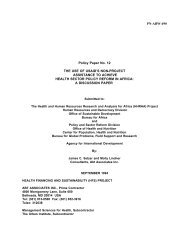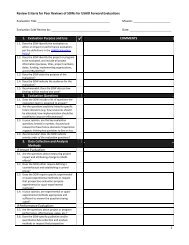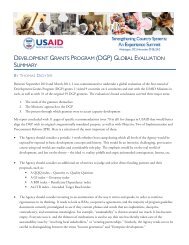Reforming Public Procurement in Emerging Market ... - KDID Portal
Reforming Public Procurement in Emerging Market ... - KDID Portal
Reforming Public Procurement in Emerging Market ... - KDID Portal
You also want an ePaper? Increase the reach of your titles
YUMPU automatically turns print PDFs into web optimized ePapers that Google loves.
<strong>Reform<strong>in</strong>g</strong> <strong>Public</strong> <strong>Procurement</strong> -- Syquia<br />
Foreign aid <strong>in</strong>stitutions that encourage legislative and <strong>in</strong>stitutional changes <strong>in</strong> develop<strong>in</strong>g countries<br />
may face obstacles <strong>in</strong> ga<strong>in</strong><strong>in</strong>g the confidence of the central government, and even greater difficulty <strong>in</strong><br />
garner<strong>in</strong>g support from local governments and their constituents. Or, they may encounter<br />
governments that readily pass reform laws and regulations, but then fail to implement them because<br />
there was never true local ownership of the reforms.<br />
In approach<strong>in</strong>g reform of public procurement policies, systems and practices, avoid<strong>in</strong>g these<br />
situations requires careful plann<strong>in</strong>g, sound advice and constant attention to the needs and <strong>in</strong>terests of<br />
various stakeholders at the national and local level, and of the private sector and civil society.<br />
This study looks at the procurement reform process as compris<strong>in</strong>g five basic steps:<br />
Step 1: Assess<strong>in</strong>g the national public procurement system and practices, develop<strong>in</strong>g the strategy<br />
and plann<strong>in</strong>g the approach<br />
Step 2: Develop<strong>in</strong>g or improv<strong>in</strong>g the legal framework<br />
Step 3: Develop<strong>in</strong>g the oversight and <strong>in</strong>stitutional framework<br />
Step 4: Conduct<strong>in</strong>g capacity build<strong>in</strong>g programs<br />
Step 5: Assess<strong>in</strong>g the impact of reforms at both the central and local levels<br />
These steps are roughly sequential but not strictly consecutive, and they are designed to ensure a<br />
proper fit between <strong>in</strong>ternational best practices and the develop<strong>in</strong>g country context. The entire process<br />
may take from four to six years to complete, and should be viewed not so much as a one-time event,<br />
but rather as a cont<strong>in</strong>uous cycle: Each step feeds <strong>in</strong>to the next, and as each cycle ends with an impact<br />
assessment, the results of that assessment similarly feed <strong>in</strong>to the next national public procurement<br />
assessment, identify<strong>in</strong>g gaps that have not been addressed, and <strong>in</strong>form<strong>in</strong>g a new strategy and approach<br />
to guide the next round of reforms.<br />
The follow<strong>in</strong>g sections are based on real case examples from the Philipp<strong>in</strong>es, Lao DPR, Vietnam and<br />
Ghana, as well as on a wide review of literature and <strong>in</strong>ternational documentation. These sections<br />
describe this procurement reform cycle <strong>in</strong> detail and provide <strong>in</strong>sight <strong>in</strong>to how these steps have been or<br />
could be implemented. The conclud<strong>in</strong>g section br<strong>in</strong>gs together the five-step process, discuss<strong>in</strong>g its<br />
implementation and timeframes.<br />
3 Step One: Assess the national public procurement system and practices, develop the<br />
strategy and plan the approach<br />
3.1 Us<strong>in</strong>g the Basel<strong>in</strong>e Indicators System (BIS) to assess national public procurement systems<br />
The Round Table on Strengthen<strong>in</strong>g <strong>Procurement</strong> Capacities <strong>in</strong> Develop<strong>in</strong>g Countries, a jo<strong>in</strong>t <strong>in</strong>itiative<br />
of the World Bank and of the Organization for Economic Co-operation and Development’s<br />
Development Assistance Group (OECD-DAC), recently <strong>in</strong>troduced the Basel<strong>in</strong>e Indicators System<br />
(BIS). The BIS measures the quality of a country’s procurement policies, systems and <strong>in</strong>stitutional<br />
capacity based on several core <strong>in</strong>dicators. viii In December 2004, representatives from develop<strong>in</strong>g<br />
countries, multilateral and bilateral development <strong>in</strong>stitutions and other participants <strong>in</strong> the Round Table<br />
signed the “Johannesburg Declaration,” which committed participants to adopt the BIS as the agreed<br />
<strong>in</strong>ternational standards for assessment of national procurement systems.<br />
Fiscal Reform and Economic Governance Project 2







